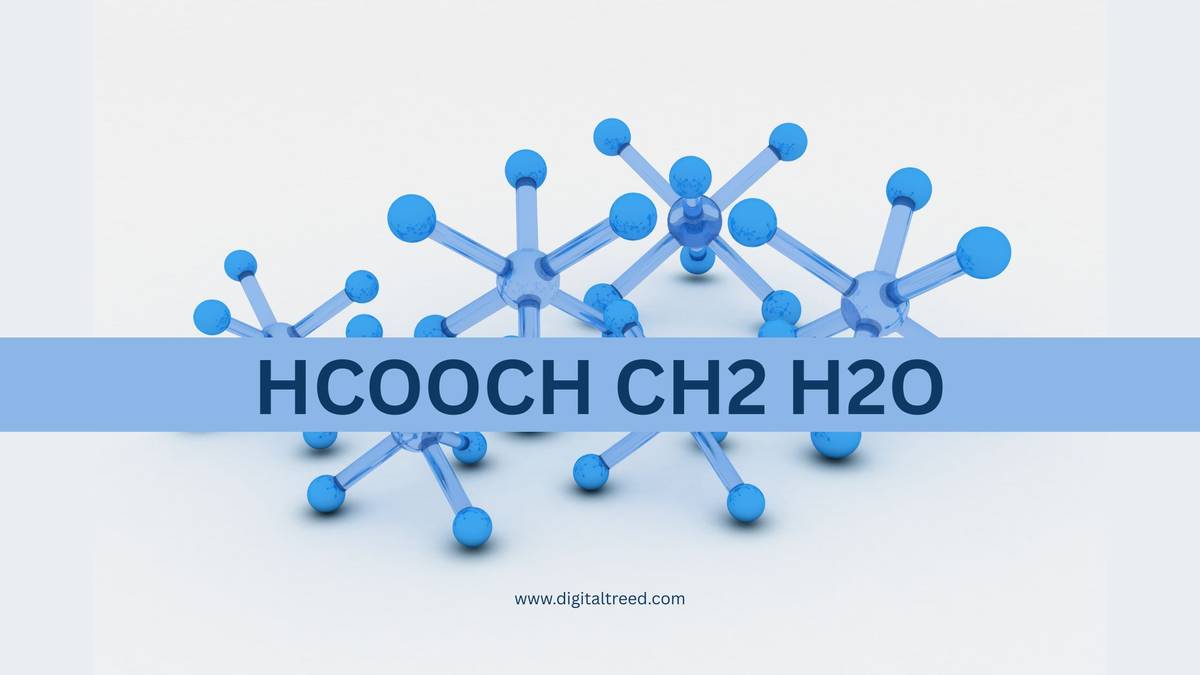Methyl formate, chemical formula HCOOCH₃, is one of the common esters utilized in many industrial applications. When hydrolysis is carried out with water (H₂O), formic acid (HCOOH) and methanol (CH₃OH) are produced. The reaction is essential in organic chemistry, demonstrating principles of ester hydrolysis but with great industrial significance.
The reaction is possible under acid or alkaline conditions, both with distinct merits. Knowledge of HCOOCH CH2 H2O in detail explains both the chemical relevance and real-world applications.
HCOOCH CH2 H2O: The Chemical
The hydrolysis of methyl formate is an uncomplicated reaction where the ester linkage is broken to form an acid and an alcohol. The chemical equation is represented as:
HCOOCH₃ + H₂O → HCOOH +
This reaction illustrates water, frequently with an acid catalyst, attacking the ester molecule to produce two different products. The mechanism for this reaction highlights nucleophilic substitution, with water as the nucleophile. The protonation of the ester's carbonyl group under acidic conditions makes it more reactive and helps in rupturing the ester linkage.
For industrial use, acidic hydrolysis is preferred because it is so efficient and can provide high yields. Basic hydrolysis, though, causes other problems, including the necessity of neutralizing the resulting solution.
HCOOCH CH2 H2O: Reaction Mechanism
The hydrolysis of methyl formate goes in a series of clearly defined steps, especially under acidic conditions:
Protonation of the Ester
In the first step, the oxygen atom of the carbonyl group of the methyl formate is protonated with an acid. This makes the carbonyl carbon more electrophilic, hence more appealing to nucleophilic attack.
Nucleophilic Attack of Water
The water molecule then strikes the protonated carbonyl carbon, forming a tetrahedral intermediate. This is an intermediate structure which comprises both the initial ester and the introduced water molecule.
Rearrangement and Bond Cleavage
In the intermediate, there is proton transfer, which leads to the cleavage of the ester. This step leaves behind a protonated formic acid, with methanol being produced as the byproduct.
Deprotonation of Formic Acid
Finally, protonated formic acid releases an H+ ion to produce the stable product, formic acid.
Deprotonation of Formic Acid
This mechanism shows how catalytic acids are effective in speeding up the reaction and maximizing product yield. It also demonstrates the underlying principles of nucleophilic substitution and organic chemistry bond cleavage.
Industrial Applications of Hydrolysis
Methyl formate hydrolysis is of great industrial importance since it can yield formic acid and methanol, both of which have vast applications.
Formic Acid Production
Formic acid, or methanoic acid, finds application in many industries. Its use varies from the processing of leather and dyeing of fabrics to agriculture, where it acts as an antibacterial and preservative. Due to the simplicity and effectiveness of the hydrolysis of methyl formate, it stands as an industrial method of choice for the production of formic acid.
Methanol production
Methanol is an extremely adaptable chemical that is utilized for fuel manufacturing, chemical synthesis, and as an industrial solvent. It is an essential feedstock for the production of formaldehyde, acetic acid, and plastics. Methanol's potential use in clean energy, especially in fuel cells, further highlights the expanding significance of the substance in worldwide markets.
The fact that these two products are obtained through a single reaction reflects the value and efficacy of methyl formate hydrolysis in industrial applications.
Factors affecting the reaction
There are several factors that affect both the yield and the rate of hydrolysis of methyl formate:
Catalysts
The reaction is often accelerated with acidic catalysts, for example, with sulfuric acid. The acidic catalysts protonate the ester, making it more reactive.
Temperatures
Increasing temperatures supply the activation energy to overcome barriers to reaction, leading to an increased reaction velocity. Excessive heat, though, can cause side reactions, so temperature control becomes necessary.
Water availability
An excess of water favors the formation of the product. As Le Chatelier's principle states, removing one of the products, like methanol, also favors the completion of the reaction.
Reaction environment
The decision to use acidic or basic conditions impacts the reaction's efficacy and side products. Most often, acidic hydrolysis is utilized because it is easier and has purer product isolation.
HCOOCH CH2 H2O Safety Considerations Care must be exercised in managing the reactants and products of methyl formate hydrolysis. It is very flammable and can prove harmful when inhaled or swallowed.
Formic acid is corrosive and may cause burns to the skin or damage to the eye. Methanol is also toxic and can cause burns, with possible health effects from exposure. Safe handling, personal protective equipment, and ventilation must be provided to prevent accidents.
Significance in Organic Chemistry
Methyl formate hydrolysis is an organic chemistry model reaction, which reflects essential concepts like nucleophilic substitution and the dynamics of equilibrium. It is an introductory reaction to learning about ester chemistry and how catalysis aids in the processes of bond breaking. It is more than just relevant in the lab, as it also reflects principles with applications for the industrial-scale synthesis of chemicals.
Conclusion
Methyl formate hydrolysis to formic acid and methanol is not simply a chemical reaction. It is an important procedure with far-reaching applications in industrial chemistry and elsewhere. Knowing the reaction process, optimization of conditions, and provision of safe procedures facilitates effective manufacturing of these precious compounds. Both in the lab or in industrial manufacturing, this reaction still exemplifies the utility of chemistry in answering real-world problems.
Frequently Asked Questions
1. What is the chemical equation for hydrolysis of methyl formate?
The hydrolysis of methyl formate is expressed as: HCOOCH₃ + H₂O → HCOOH + The reaction yields formic acid (HCOOH) and methanol (CH₃OH )
2. For what purpose is methyl formate utilized?
Methyl formate is frequently utilized as a solvent, chemical synthesis intermediate, and in the production of formic acid and methanol. It is likewise utilized in the manufacture of pharmaceuticals and pesticides.
3. What conditions are required for the hydrolysis of methyl formate?
The hydrolysis is normally under acidic or alkaline conditions. Acid hydrolysis, with the use of catalysts such as sulfuric acid, is mostly carried out in industries. It also needs water and temperatures under controlled conditions to favor the reaction.
I have been serving web content with my passionate writing skills since 2020. My skills have benefited clients from 20 countries, resulting in 10x audience interactions, improved readability, and SEO-friendly content.

About us and this blog
We are a digital marketing company with a focus on helping our customers achieve great results across several key areas.
Request a free quote
We offer professional SEO services that help websites increase their organic search score drastically in order to compete for the highest rankings even when it comes to highly competitive keywords.










